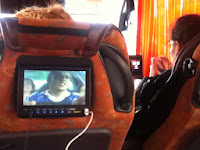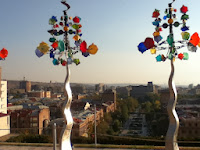 Tehran is the capital city of Iran. A bustling metropolis of 14 million people, it is situated at the foot of the towering Alborz mountain range.
Tehran is the capital city of Iran. A bustling metropolis of 14 million people, it is situated at the foot of the towering Alborz mountain range.
Our arrival of the city was tiring. There was no sale office to seat travelers, and we did not know where we were in the city. We walked around for coffee shops to seat in at 5:30 am, and found a small sale office as our shelter to read tour books and asked local travelers to find the way a hotel.
 We are budget travelers so we could not just jump into a taxi. We already learned how the taxi drivers rip off foreigners, regardless how hard we bargain even with locals' help. A taxi driver told us to use a free shuttle bus to get to the closest Metro stop, and then a kind young lady in the shuttle led us via the Metro and taught us the right stop to switch lines. I was very gradual to travel with Ana who was great in using maps and learning new languages. We got out of Metro and walked to the 1st hotel but we did not like it. I stayed there to watch our bags while Ana was hunting for a better near by hotel. She came back after 30 minutes and then we checked a much better hotel to shower and relax.
We are budget travelers so we could not just jump into a taxi. We already learned how the taxi drivers rip off foreigners, regardless how hard we bargain even with locals' help. A taxi driver told us to use a free shuttle bus to get to the closest Metro stop, and then a kind young lady in the shuttle led us via the Metro and taught us the right stop to switch lines. I was very gradual to travel with Ana who was great in using maps and learning new languages. We got out of Metro and walked to the 1st hotel but we did not like it. I stayed there to watch our bags while Ana was hunting for a better near by hotel. She came back after 30 minutes and then we checked a much better hotel to shower and relax.  When taking breakfast in the lobby, I spotted in the hotel lobby my Chinese backpacker friend met in a Trabzon (turkey) tour. We chat about his Iran trip and then toured Tehran together for one day. Ana had to take care her own business that day.
When taking breakfast in the lobby, I spotted in the hotel lobby my Chinese backpacker friend met in a Trabzon (turkey) tour. We chat about his Iran trip and then toured Tehran together for one day. Ana had to take care her own business that day. 
 The old US embassy in Tehran and the events emanating from it have
had a dramatic and profound influence on the recent history
of the country. From a bunker beneath the embassy
building, CIA operatives orchestrated a coup d’état in 1953
that brought down the government of Mohammad
Mossadegh (Click here). For the next 25 years, US support for and influence
over Mohammad Reza Shah was implemented largely from
this building. Unfortunately, it’s rarely open to the
public – usually only from 1 to 10 February. Despite this, the embassy’s colorful history and more colorful murals along the front wall mean most travelers
come for a look.
The old US embassy in Tehran and the events emanating from it have
had a dramatic and profound influence on the recent history
of the country. From a bunker beneath the embassy
building, CIA operatives orchestrated a coup d’état in 1953
that brought down the government of Mohammad
Mossadegh (Click here). For the next 25 years, US support for and influence
over Mohammad Reza Shah was implemented largely from
this building. Unfortunately, it’s rarely open to the
public – usually only from 1 to 10 February. Despite this, the embassy’s colorful history and more colorful murals along the front wall mean most travelers
come for a look.  Iran's National Rug Gallery exhibits a variety of Persian carpets from all over Iran, dating from 18th century to present. It has a library that contains 7,000 books, but not open to public. My Chinese friend is very into carpets and shared a lot of his knowledge with me. An interesting thing about our journey to this museum was that the locals including rapid bus staff, tried to help us to get there but actually detoured us a loop of more than 40 minutes. We should have just followed the maps in the tour book. Be careful with these people with best intent but not the knowledge! Always read the tour book at a quilt corner to avoid attention of these "helpers".
Iran's National Rug Gallery exhibits a variety of Persian carpets from all over Iran, dating from 18th century to present. It has a library that contains 7,000 books, but not open to public. My Chinese friend is very into carpets and shared a lot of his knowledge with me. An interesting thing about our journey to this museum was that the locals including rapid bus staff, tried to help us to get there but actually detoured us a loop of more than 40 minutes. We should have just followed the maps in the tour book. Be careful with these people with best intent but not the knowledge! Always read the tour book at a quilt corner to avoid attention of these "helpers". i followed my friend to stop by Tehran's massive bazaar in the city's south (Metro: Panzdah-e-khordad), To pick up a rug he purchased. The main entrance on 15 Khordad Ave leads to a labyrinth of stalls and shops that were once the engine room of Iran's commodity markets and one of Imam Khomeini's greatest sources of conservative, pro-Revolution support. As usual, shops are clustered according to the products they sell.
i followed my friend to stop by Tehran's massive bazaar in the city's south (Metro: Panzdah-e-khordad), To pick up a rug he purchased. The main entrance on 15 Khordad Ave leads to a labyrinth of stalls and shops that were once the engine room of Iran's commodity markets and one of Imam Khomeini's greatest sources of conservative, pro-Revolution support. As usual, shops are clustered according to the products they sell.  I and Ana moved to a friend's house in the north side of the city, so we did not even sleep over night there for the night we paid. My friend has another visitor from Taiwan, and he took us to a very good Chinese restaurant (unfortunately, the only Chinese restaurant in Tehran now). We had a late start the second day. The museums in Tehran increased admission so much that we only visited two.
I and Ana moved to a friend's house in the north side of the city, so we did not even sleep over night there for the night we paid. My friend has another visitor from Taiwan, and he took us to a very good Chinese restaurant (unfortunately, the only Chinese restaurant in Tehran now). We had a late start the second day. The museums in Tehran increased admission so much that we only visited two. 
 Golestan Palace is the oldest of the historic monuments in Tehran. The Complex consists of 17 palaces, museums, and Halls. The Golestan (Rose Garden) citadel is one of mainly visited places in Tehran, which was the Qajars' royal residence, and its garden is an oasis of coolness and peace in the heart of the city. The major building, architecturally unpretentious, houses a museum with objects from the Qajar period in the self-important style of last century. In the Golestan garden, a one-story pavilion to the right and a short distance from the entrance, shelters one of the best organized museums in Tehran. It encloses about thirty showcases presenting almost everything related to Iran, which makes up the critical originality of Iranian life in the a variety of provinces of the country.
Golestan Palace is the oldest of the historic monuments in Tehran. The Complex consists of 17 palaces, museums, and Halls. The Golestan (Rose Garden) citadel is one of mainly visited places in Tehran, which was the Qajars' royal residence, and its garden is an oasis of coolness and peace in the heart of the city. The major building, architecturally unpretentious, houses a museum with objects from the Qajar period in the self-important style of last century. In the Golestan garden, a one-story pavilion to the right and a short distance from the entrance, shelters one of the best organized museums in Tehran. It encloses about thirty showcases presenting almost everything related to Iran, which makes up the critical originality of Iranian life in the a variety of provinces of the country. The National Museum of Iran has ceramics, stone figures and carvings dating all the way back to around the 5th millennium BC. It is the combination of two museums, the old building dedicated pre-Islamic collection dating from Neolithic all the way to the Sassanid period and the new building dedicated to Iran's 1,400-year Islamic history.
The National Museum of Iran has ceramics, stone figures and carvings dating all the way back to around the 5th millennium BC. It is the combination of two museums, the old building dedicated pre-Islamic collection dating from Neolithic all the way to the Sassanid period and the new building dedicated to Iran's 1,400-year Islamic history. A1one (aka Alonewriter, tanha) graffiti and street art works are a sort of interesting stuff in Teheran's Urban Space.
A1one (aka Alonewriter, tanha) graffiti and street art works are a sort of interesting stuff in Teheran's Urban Space. 







































